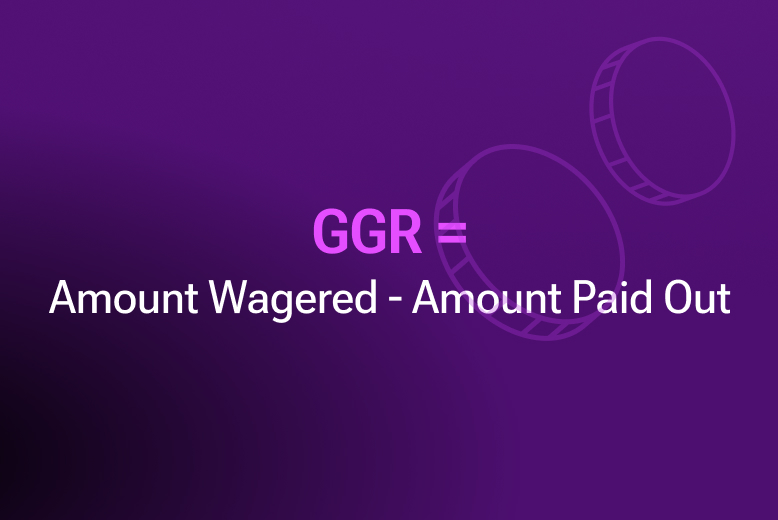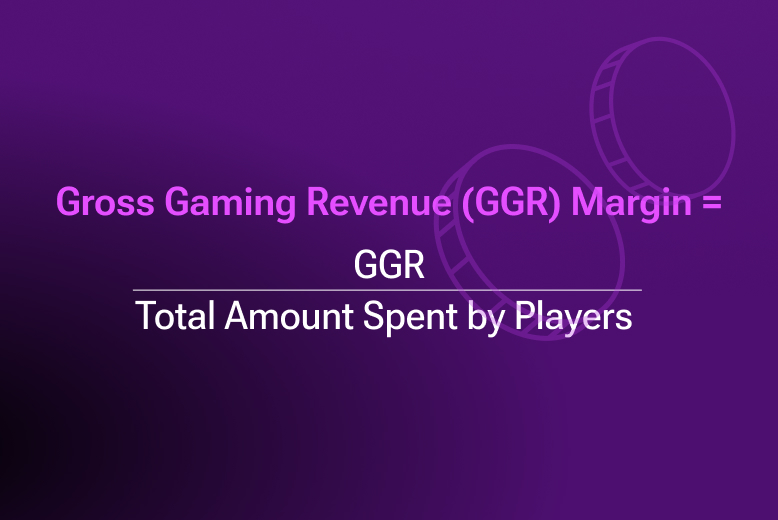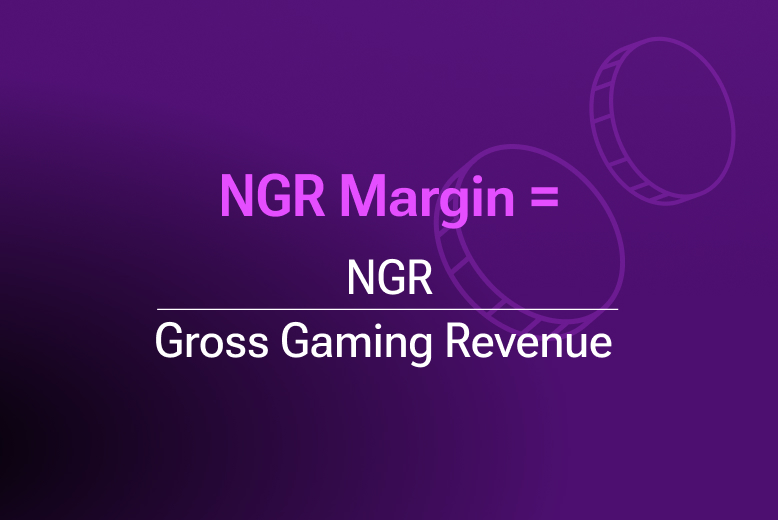Every business owner or entrepreneur in the online gambling industry needs a fundamental grasp of the key performance indicators (KPIs). The most important metrics for measuring your progress include gross gaming revenue (GGR) and net gaming revenue (NGR). Understanding these money-related KPIs is essential for determining if your iGaming business is making profits or growing as expected. This is especially relevant when analyzing online casino revenue trends over time or comparing your performance to competitors.
Understanding how to calculate gross gaming revenue and net gaming revenue is critical for online operators to extract valuable data about their strengths and identify areas for improvement to sustain their businesses. For those new to the terminology, the difference between GGR and NGR is that GGR represents the total amount wagered minus player winnings, while NGR also subtracts bonuses, fees, and operational costs — giving you a clearer view of actual profitability.
To survive in the fiercely competitive gaming industry, a casino operator must monitor their gross gaming revenue (GGR) and net gaming revenue (NGR) to control costs and monitor performance. They can also make informed decisions and comply with tax-related laws.
What Is Gross Gaming Revenue (GGR)?
The question is, what is GGR, and how important a metric is it for an operator? Before we answer this question, we should clarify that gross gaming revenue (GGR) is also known as gross game win or gross gaming yield. As the name implies, it is a key performance indicator used by gambling operators to gauge the gross revenue generated from the bets placed by players over a specific period. In simple terms, the GGR casino definition refers to the total amount wagered by players minus the total winnings paid out. GGR represents the amount of wagered money the operator remains with after paying out all player winnings. It is the total revenue (gross revenue) generated by an iGaming business before deducting any expenses or costs incurred while operating the casino or sportsbook business.
To calculate GGR, you need to subtract the sum paid out to players from the total amount of money those players have spent on real-money wagers. The result you get after the calculation represents the amount of money players have lost within a specific period. Operators can use it to calculate their weekly, monthly, quarterly, or yearly gaming sales.
Online and land-based casino operators can use gross revenue as a KPI to measure their revenue growth over time. A high GGR or high average revenue per user usually indicates that your business is doing well financially. However, it is crucial to calculate your net gaming revenue to establish if you are making profits or losses.
The benefits of knowing your gross gaming revenue go beyond tracking gaming sales over time. Operators can use this parameter to make strategic business decisions about their services, promotions, and player acquisition and retention strategies. Moreover, GGR financial data provides useful insights into a gambling platform’s competitiveness in the gaming industry. It showcases the brand’s capacity to remain relevant in a sector where new businesses launch every week. For example, publicly available reports on companies like Gamingtec revenue often include GGR trends to demonstrate financial performance.
Gross gaming revenue also helps regulatory bodies determine how much tax a gambling business should pay to the government. Once an operator knows how to calculate GGR, they can establish the correct tax amount, predict it, and pay accordingly to ensure compliance with the law. This is important because operators who adhere to the rules are the only ones who can keep their gaming licences.
Formula for Gross Gaming Revenue
Learning how to calculate gross gaming revenue is an important consideration for any operator. New and established businesses in the gambling space may be able to determine their gross revenue without the help of a professional. However, accounting for iGaming goes beyond calculating gross gambling yield. For this reason, serious operators usually let accountants calculate the gross revenue and other vital key performance indicators to measure growth.
The steps used to calculate GGR are straightforward. The gross gaming revenue formula is simple: it’s the amount of money players spend on wagers minus the amount paid out as winnings. See the formula below.
GGR = Amount Wagered by Players – Amount Paid Out as Winnings

GGR Margin
GGR margin for an online gaming business is another critical factor to consider when evaluating its overall performance. It refers to the gross gaming revenue calculated as a percentage. In other words, the GGR margin is the casino’s gross revenue expressed as a percentage of the total amount of money wagered by players. Achieving a higher GGR margin should be your ultimate goal as an operator. Higher values generally show that the business retains a substantial amount of money from all real-money bets placed by players. Operators can use this metric to measure the financial health of their business.
Calculating GGR Margin
Calculating the GGR margin is easy once you know how to determine your gross gaming revenue. The two most important figures to consider are the total amount of money wagered by players and the amount paid out to players as winnings. You can determine how much of the money that players wager remains with the casino or sportsbook using this information. By dividing the GGR by the total amount of money gamblers spent, you can calculate the GGR margin. Here is the formula used to calculate the GGR margin:
Gross Gaming Revenue (GGR) Margin = GGR/Total Amount Spent by Players
GGR Margin Example
Let’s say players at an online casino have spent $100,000 and you want to calculate your yearly GGR margin. We’ll also assume that the total money won and paid out as winnings is $70,000. You can calculate the margin using the following formula:.
GGR = Amount Wagered – Amount Paid Out
Based on this formula, we need to subtract $70,000 from $100,000
Therefore, the GGR is $30,000
Remember that GGR Margin = GGR/Total Amount Spent by Players
Using this formula, the GGR Margin = $30,000/$100,000
So, the GGR margin for that year is 0.30 or 30%

What Is Net Gaming Revenue (NGR)?
Understanding the relationship between GGR and NGR is another paramount step if you want to measure your success. Net gaming revenue is a key performance indicator that helps business operators in the iGaming industry track profitability. As mentioned above, the GGR does not consider the expenses associated with operating an online or land-based gaming business. On the other hand, you must include the amount spent on various expenses to calculate the NGR for your business. To know how profitable your venture is, you need to subtract all expenses from the total revenue generated in a certain period.
Let’s talk about the different types of expenses gambling operators can incur. First, operators have to release winnings to players who have placed real-money bets and won. Secondly, casino businesses spend money on advertising and affiliate marketing to create brand awareness and acquire players. Other common expenses include commissions for using payment gateways and payments to various software providers.
Another noteworthy expense is the amount of money spent on licencing and taxation. Gaming operators are required to obtain licences from governments or gambling authorities in the targeted jurisdictions. Such permits are usually costly because they often include an application fee, the cost of the licence, and annual fees. Moreover, gaming businesses are generally obliged to pay taxes based on the total revenue generated from player bets. Such charges have a significant impact on the amount the operator can keep by the end of the month or year.
An operator can gain insight into how well a gambling establishment converts player deposits into revenue by calculating the NGR. If the NGR-to-deposit ratio is high, it means that the business is generating more money from player deposits. This is great news because it indicates that the casino or sportsbook is growing financially. It represents the amount of profit the operator makes. As with GGR, knowing the NGR can help gaming brands make the right decisions to improve performance and profitability.
The Formula for Net Gaming Revenue
Calculating NGR entails subtracting the amount paid to players and other expenses from the total revenue generated. However, we must remember that the costs and expenses incurred vary from one business to another. For example, established casinos may not need to pay licence application fees if they already have a valid gaming licence. Moreover, not all calculations may include operating and marketing costs, so the numbers may vary. The following simplified formula shows how gaming business operators can calculate their NGR.
Net Gaming Revenue (NGR) = GGR – Expenses (Taxes, Commissions, Bonuses, Advertising Costs, Licencing Fees, Payment Method Fees, and Payments to Software Providers)
NGR Margin
Net gaming revenue margin indicates the percentage of bets a gambling operator keeps as profit. The objective is to improve NGR margins if you want to operate a profitable casino or sportsbook business. Higher net gaming revenue margins show that your brand is efficiently converting player bets into profits. In that case, the expenses incurred are also reasonable. Industry averages range from one casino game to another.
Calculating NGR Margin
Gambling businesses need a clear understanding of their gross gaming revenue and expenses to accurately calculate NGR margins. The NGR margin is calculated by dividing the NGR by gross gaming revenue. See the following formula:
NGR Margin = NGR / Gross Gaming Revenue
NGR Margin Example
Let’s say your GGR is $120,000. You have also spent $20,000 on bonuses, $13,000 on taxes, and $17,000 on operating costs. In that case, your NGR would be:
$120,000 – ($20,000 + $13,000 + $17,000) = $70,000
Your NGR margin would be:
$70,000/$120,000 = 0.5833 or 58.33%

Main Differences between GGR and NGR
Successful businesses in the iGaming industry can make useful decisions based on data acquired after calculating their gross gaming revenue and net gaming revenue. These vital KPIs can be used in business analytics to track your progress within a specified duration. Therefore, understanding the difference between GGR and NGR is crucial. Here is what you need to know about these two popular metrics in iGaming.
Gross Gaming Revenue
- GGR is the amount wagered by players minus the amount paid out as winnings
- GGR is the money generated from the losses made by players
- GGR does not consider operating costs and other expenses
Net Gaming Revenue
- NGR is the revenue generated once all expenses are deducted
- NGR indicates the amount of profit made by the business
- NGR considers taxes, promotional costs, commissions, and licencing fees
Other KPIs
GGR and NGR are not the only key performance indicators to consider as a gambling business operator. There are other money- and people-related KPIs. The following metrics provide valuable information on different aspects of a casino’s operations that gaming businesses can use to make informed decisions, improve profitability, and enhance overall performance.
- Bets-to-Deposits: A comparison between the amount of money spent on bets and the amount deposited by players.
- NGR-to-Deposits: This KPI denotes the percentage of deposits that a casino converts into revenue when players wager on games or sports.
- Customer Lifetime Value (LTV): An estimate of the total revenue the business can expect from one player over time.
- Average Revenue Per User (ARPU): This refers to the average revenue the casino generates from each player over time.
- Deposit Conversion Rate: The percentage of registered players who deposit funds.
- Churn Rate: This is the percentage of inactive players over a certain period.
- Cost Per Acquisition (CPA): This metric measures the cost of acquiring a new customer.
- Daily Active Users (DAU) and Monthly Active Users (MAU): The number of active players who stay active in the casino every day or month, respectively.
| Aspect | GGR (Gross Gaming Revenue) | NGR (Net Gaming Revenue) |
|---|---|---|
| Definition | Total amount wagered by players minus total winnings paid out | GGR minus all operating costs, taxes, fees, bonuses, and other expenses |
| Alternative Terms | Gross game win, gross gaming yield | Net revenue, profit after expenses |
| Formula | GGR = Total Wagers – Winnings Paid | NGR = GGR – (Taxes + Fees + Bonuses + Marketing + Licencing + Provider Costs) |
| What It Shows | Total gross income from players before costs | Actual profit or income retained after all business-related expenses |
| Includes Expenses? | No | Yes |
| Used For | Measuring gross cash flow, regulatory reporting, tax calculation | Measuring profitability, financial planning, internal reporting |
| Margin Formula | GGR Margin = GGR / Total Wagers | NGR Margin = NGR / GGR |
| Example | $100,000 in bets – $70,000 in payouts = $30,000 GGR | $30,000 GGR – $13,000 (expenses) = $17,000 NGR |
| Focus Area | Revenue from gameplay activity | Operational efficiency and profit |
| Used By | Operators, regulators, investors | Operators, financial analysts, business owners |
| Importance | Helps track game-level performance and tax obligations | Shows real profitability and business health |
Conclusion
Overall, GGR and NGR are two important parameters for calculating gaming revenue for businesses in the online gaming world. Operators, entrepreneurs, or business owners in this sector can offer an improved gaming experience to their customers if they understand what these money-related key performance indicators mean. The information acquired can help assess a company’s revenue and expenses over time. With this data, operators can easily make informed decisions to improve their performance and meet the needs of various players.



 Upd: 26 June 2025
Upd: 26 June 2025 




















